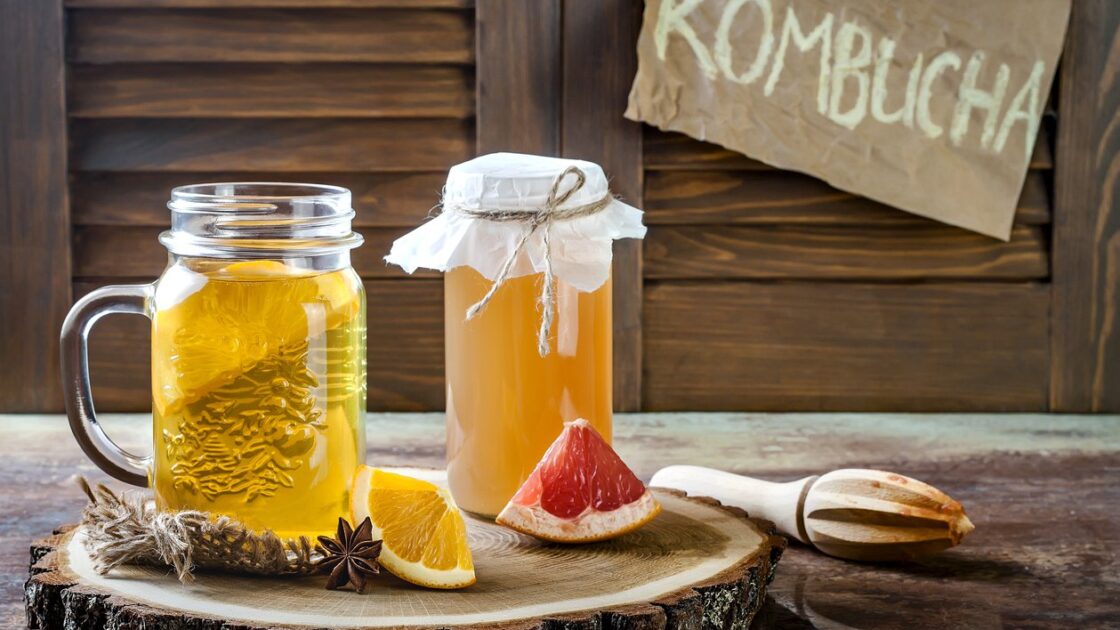Yasss! This 4-Ingredient Kombucha Recipe is Easy Homemade Fermented Goodness
Gut supportive yumminess.

*Affiliate disclosure.
Making kombucha in your own kitchen is an easy and nutritious way to reap health benefits associated with fermented foods. This kombucha recipe is super simple. With just four ingredients, you’ll be on your way to enjoying this trendy and healthy drink in no time–and without paying the high price of store-bought kombucha.
Health Benefits of Kombucha
Along with being a good source of gut supportive probiotics, kombucha contains trace vitamins and minerals along with beneficial enzymes and antioxidants thought to aid in detoxification, antioxidation, and promotion of immunity.
According to a 2014 article published in Food Science and Technology, numerous health benefits have been associated with kombucha. These include stimulating the immune system, aiding in digestion, protecting against cancer and cardiovascular diseases, preventing microbial infections, and free-radical scavenging activities, among others.
Of course, kombucha is not a cure-all. Sandor Ellix Katz, fermentation wiz and author of “The Art of Fermentation” notes, “Kombucha is neither panacea nor peril. Like any ferment, it contains unique metabolic by-products and living bacterial cultures that may or may not agree with you,” he notes. “Try some, starting with small servings, and see how it tastes and feels to you.”.
If you are into the bubbly “booch”, this kombucha recipe is deliciously simple.
Making Kombucha
Kombucha is made from water, caffeinated black or green tea, sugar, and a SCOBY, an acronym for symbiotic culture of bacteria and yeast, which is also called the mother.
These ingredients are placed in a large jar and left to ferment for seven to ten days. During this time, the SCOBY snacks on the sugar molecules to produce gas, and therefore a fizzy and sparkling fermented drink.
Sugar is essential to the kombucha making process; so don’t fear dumping it in. By the end of fermentation, most of the sugar has been metabolized by the SCOBY therefore reducing the sugar content of your homemade kombucha.
After the first ferment, the kombucha can be consumed, or a secondary fermentation process can be done to add in extra carbonation and flavoring, such as ginger, cinnamon, honey, or berries.
Julie of Cultures for Health notes that a second fermentation period “allows the flavors to meld and achieve a deeper and more complex flavor profile.” And she explains that bottled in an airtight container, “the carbon dioxide produced during fermentation will remain, giving the kombucha the fizzy texture it is often known for.”
Other flavorful second ferment ideas include:
Buying A SCOBY
Before embarking on the kombucha recipe making process, you’ll need to purchase a SCOBY mother or DIY kombucha kit including the mother. Katz says, “You can purchase a mother, or obtain one from another home kombucha maker via online trading posts, or grow one from commercially available live-culture kombucha.”
Purchasing a SCOBY should cost less than ten dollars, or free, if you find a fellow fermenting friend. You can even grow your own SCOBY mother with a bottle of plain kombucha.
According to Katz, growing your own kombucha SCOBY mother is easy. Simply pour a bottle of plain kombucha into a wide-mouth glass jar, cover with a cheesecloth, and let sit for about a week “for a skin to form on the surface. This skin is a kombucha SCOBY.”
Once you have a fully developed SCOBY, it will have many layers that can be peeled off to start other batches of kombucha, or share with friends.
You’ll also need a large glass gallon jar for the fermentation and a piece of fabric or cheesecloth to cover the jar with.
Ingredients
Preparation
- Heat eight cups of water in a large pot over high heat. Add the tea bags and let them steep for a half hour. Once steeped, stir in the sugar until it is completely dissolved. Mix in the remaining water and remove the pot from the stove.
- Once the sweetened tea reaches room temperature, pour it into the glass jar along with the SCOBY.
- Place the fabric over the opening of the jar and seal with a rubber band. Place the jar in a dark room with controlled warm temperature and no direct sunlight.
- Let the kombucha ferment for seven days. After seven days, taste the mixture to see if it’s bubbly enough for your liking. If not, let it ferment for a few more days.
- Once kombucha is fermented, pour into glass jars and store in the refrigerator. Pour out the SCOBY and “baby” SCOBY that were formed and store them with a bit of the kombucha in a lightly sealed jar in the fridge until you want to make a new batch.
*Note! This article contains affiliate links that are independently sourced and vetted by our editorial team which we may earn a commission on. This helps us reduce the number of ads we serve on Organic Authority and help deliver you a better user experience. We are here to help you navigate the overwhelming world of consumer products to source and uncover thoughtfully made, conscious clean products for you and your family.

